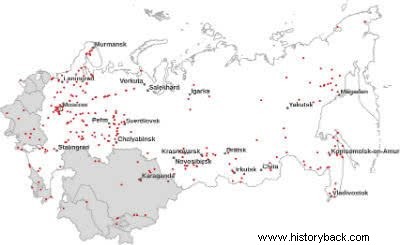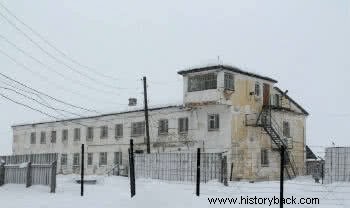Gulag is an acronym, in Russian, for Central Administration of the Fields. These were prison camps where detainees were punished with forced labor, physical and psychological torture.
The term “Gulag” was popularized in the West thanks to the book “Gulag Archipelago”, by Russian writer Alexander Solzhenitsyn, published in 1973 in Paris.

Origin of the Gulags
Forced labor camps have existed since the Russian Empire. However, with the fall of the monarchy and the rise of the Russian Revolution in 1917, the concentration camp system was extended to the most remote regions of the country.
The Gulags had their heyday under Stalin between 1929-1953 and went into decline after the death of the Soviet dictator. However, they were only officially abolished under Gorbachev in the 1980s, when the Soviet Union began to open up to the world.
Initially, people considered “enemies of the people” were sent to the Gulags. The first prisoners' oilcloths belonged to specific classes such as the bourgeois, priests, landowners and monarchists. There were also those who were suspected only because of their origins as Jews, Chechens and Georgians.
During the Great Purge, carried out by Stalin between 1934-1939, prisoners' profiles changed.
Any citizen accused of making the slightest criticism of the regime was sentenced to the Gulag.
Thus, university professors, members of the party opposed to Stalinist policy, could be taken to forced labor camps or exile in Siberia.
After World War II, those who lived under German occupation were accused of traitors and sent to be re-educated in the Gulags. The same fate awaited, for example, the Poles who were accused of being spies by the Soviet regime.
It is important to note that if a family member was arrested, the other relatives were also registered and monitored by the police.
Read more about Holodomor:The Great Famine in Ukraine.
Characteristics of Gulags
It is estimated that there were between 450 and 470 concentration camps. While certain sites held 200 to 500 people, others held tens of thousands. Camps could be located either in the suburbs of Moscow or in inhospitable regions of Siberia.
There were fields specialized in industrial work, those situated in forests and even fields where intellectuals designed projects for works. There were also camps whose labor was employed to erect large constructions such as the Baltic Sea Canal and the Moscow Canal.
The forced labor camps were part of the economic system proposed by Stalin to dynamize the Soviet Union. He believed that work was necessary to build the new man and the new socialist society.
In this sense, work, in addition to redeeming the criminal, would be helping to achieve the ultimate goal of Soviet socialism.
Each prisoner had to fulfill a daily quota of work in 12-hour shifts, in order to receive his full portion of food. Otherwise, he received only half. As a result, the detainee was weakened and, inevitably, died.
Likewise, the Gulags did not offer any kind of comfort and the physical and psychological tortures were constant.
In winter, in regions like Siberia, the situation worsened when prisoners had to withstand temperatures of more than -30º. In addition, prisoners were guarded by armed soldiers and ferocious dogs.
There are no accurate statistics on the number of prisoners held in the Gulags, but it is estimated that 18 million people passed through these camps.
The number of dead is more difficult to determine, as many were released two or three days before they died. Thus, scholars believe that 2 to 3 million human beings may have been starved, tortured and executed.

Gulag Perm-36 look that now functions as a museum
"Gulag Archipelago", by Alexander Solzhenitsyn
Alexander Solzhenitsyn (1918-2008) was a Russian writer and playwright. During World War II he served in the Red Army and obtained the rank of captain.
Corresponding with a friend he wrote that he doubted Stalin's abilities as a military strategist. This letter was intercepted and Solzhenitsyn was sentenced to 10 years of hard labor and perpetual exile.
This experience is told in “A Day in the Life of Ivan Denisovich”, the first book published in the USSR denouncing the atrocities committed in the prison camps.
Its publication was allowed by Nikita Krushev (1953-1964) to show that the situation was beginning to change in the USSR and that the Stalinist regime had come to an end.
The writer starts to receive thousands of letters telling similar experiences and decides to start a larger book that gathers these testimonies.
However, when Leonid Brezhnev (1964-1982) becomes president of the USSR, Soviet politics once again repressed any dissident demonstrations.
Solzhenitsyn goes to work underground and with the help of people who don't know each other. When the Soviet political police, the KGB, arrest two writers for publishing books against the regime, Solzhenitsyn goes to Estonia to finish publishing them.
The title "Gulag Archipelago" expresses the idea of how Alexander Solzhenitsyn conceived this system. To him, the Gulag was like a chain of islands that were linked together by horror and violence.
Despite being physically distant, the Gulags obeyed the KGB and treated prisoners with inhumane treatment. Therefore, he conceives them as an archipelago, where the islands present similarities even if they are not close to each other.
For this book, Alexander Solzhenitsyn was expelled from the Soviet Union and spent twenty years in exile.
Read:Greatest Dictators in History and Russia
